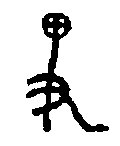|
"I became curious about
this star ... called Nuutuittuq [= 'never moves'] ... So, on
the lee side of our uquutaq (a snow windbreak) I positioned a
harpoon pointing directly at this particular star to see if it would
move. In the morning I checked it and discovered that the
Tukturjuit (Ursa Major) had changed their position completely
but the harpoon still pointed at this star ... I had discovered the
stationary star ... " (Abraham Ulayuruluk of Igloolik
according to Arctic Sky.) "The most ancient of all astronomical instruments, at least in China, was the simple vertical pole. With this one could measure the length of the sun's shadow by day to determine the solstices ... and the transits of stars by night to observe the revolution of the sidereal year. It was called pei or piao, the meaning of the former being essentially a post or pillar, and the latter an indicator. Pei can be written with the bone radical ... or with the wood radical, in which case it means a shaft or handle. Ancient oracle-bone forms of the phonetic component show a hand holding what seems to be a pole with the sun behind it at the top ...
so that although this component alone came to mean 'low' in general, it may perhaps have referred originally to the gnomon itself. This is after all an object low on the ground in comparison with the sun, and shows the long shadow of a low sun at the winter solstice, the moment which the Chinese always took as the beginning of the tropic year." (Needham 3)
This picture (from Needham 3) shows how even today in Borneo they measure the shadow of the sun with a gnomon and a gnomon template to determine summer solstice. Notice the little figure on top of the gnomon, maybe a representation of the sun (with protruding belly?). "gnomon ... indicator, esp. of a sundial ... Gr. gnōmikós (perh. through F. gnomique), f. gnōmē opinion, judgment, f. *gnō- ... see KNOW." (English Etymology) |

